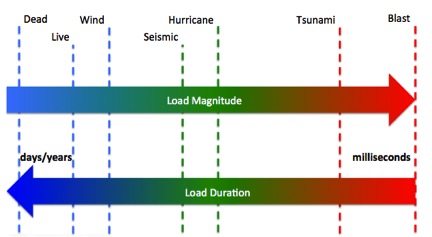
As part of our day-to-day consulting practice, we deal with what can be termed as Extraordinary Loads. I was recently in a design meeting and when I mentioned what I consider to be a fairly low blast load, the structural engineer’s eyes widened. She said that this load would change the entire design, and she would have been correct, if we were talking about an Ordinary Load. After this, it occurred to me that perhaps the concepts of Ordinary and Extraordinary Loads bear a little more explanation.
Ordinary conventional loads are based on services loads, a common terminology within the structural engineering community, that refers to a regularly occurring load encountered by a structure. Service loads include gravity loads, live loads, wind, snow, etc.. A factored combination for these high-frequency service loads take into account serviceability and strength, resulting in structures designed to withstand these loads with a certain safety factor and within a movement limitation for the comfort of building occupants.
The magnitudes of these loads are relatively low (usually measured in pounds per square foot for uniform loads) and they are applied for long durations. Because of the relatively long or continuing duration of these loads, a static analysis approach is used in design.
 On the other hand, Extraordinary Loads, including hurricanes, earthquakes, tsunamis, and explosions, have a significantly lower frequency of occurrence, and buildings designed to resist them are often assumed to experience some level of damage once the loading has passed. These loads are generally considered as a separate load case without the increase factors used for service loads. In most cases, life-safety is the main goal in design for these loads, unless the facility is deemed as mission critical and must function after an extreme event. The magnitudes of these loads can be very high (measured in pounds per square inch for uniform loads) and are applied for a relatively short period of time (measured in seconds or even milliseconds). Because of the very short duration of Extraordinary Loads, a static analysis approach would generally result in an overly conservative (and therefore cost-ineffective) design. Instead of a static analysis, a performance–based criterion utilizing a dynamic analysis approach is often used, taking into account the duration, in addition to the magnitude of the load. This distinction allows us to meet the requirements of a project, as well as provide our clients with a feasible and cost-effective design when dealing with Extraordinary Loads.
On the other hand, Extraordinary Loads, including hurricanes, earthquakes, tsunamis, and explosions, have a significantly lower frequency of occurrence, and buildings designed to resist them are often assumed to experience some level of damage once the loading has passed. These loads are generally considered as a separate load case without the increase factors used for service loads. In most cases, life-safety is the main goal in design for these loads, unless the facility is deemed as mission critical and must function after an extreme event. The magnitudes of these loads can be very high (measured in pounds per square inch for uniform loads) and are applied for a relatively short period of time (measured in seconds or even milliseconds). Because of the very short duration of Extraordinary Loads, a static analysis approach would generally result in an overly conservative (and therefore cost-ineffective) design. Instead of a static analysis, a performance–based criterion utilizing a dynamic analysis approach is often used, taking into account the duration, in addition to the magnitude of the load. This distinction allows us to meet the requirements of a project, as well as provide our clients with a feasible and cost-effective design when dealing with Extraordinary Loads.
Check out our upcoming Webinars and Face-to-Face Course for more in-depth information.
